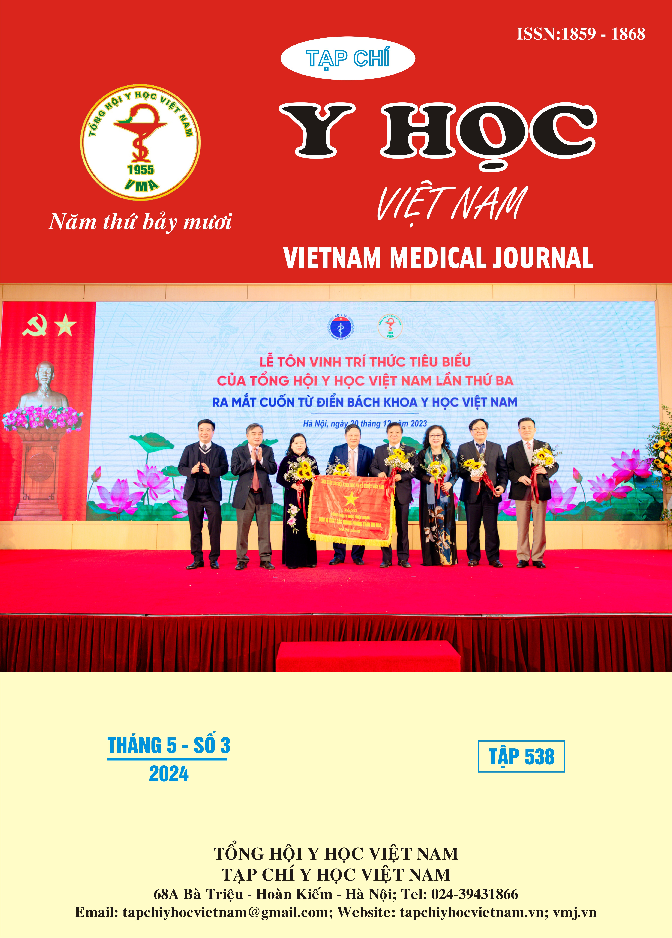EVALUATION OF THE EFFECTS OF SPECIFIC DIABETES NUTRITION ON POSPRANDIAL BLOOD GLUCOSE IN PATIENTS WITH TYPE 2 DIABETES
Main Article Content
Abstract
Objective: To initially evaluate the effects of specialized nutrition on postprandial blood glucose in patients with type 2 diabetes. Methods: a descriptive study, with nutritional intervention in 92 patients with type 2 diabetes treated as outpatients at Hospital 103. The main outcomes were blood glucose levels at 30, 60, and 120 minutes after meals and an increment in blood glucose. Results: Blood glucose and the percentage of blood glucose control after meals at 30 minutes and 120 minutes after meals were not statistically different between the diabetes-specific formula and standard meal. However, blood glucose at 60 and 120 minutes after meals of the diabetes-specific formula group were significantly lower than standard meal (at 60 minutes: 11.14 mmol/L vs 12.69 mmol/L and at 120 minutes: 9.26 mmol/L vs 11.06 mmol/L, p < 0.05). The percentage of achieving postprandial blood glucose control targets at 60 minutes was significantly higher in the diabetes-specific formula groups compared with standard meal group (p < 0.005). Patients using diabetes-specific formula had a significantly lower increament in blood glucose after meals at 30, 60, and 120 minutes after meals than the standard meal group (p < 0.05). Conclusion: Among patients with type 2 diabetes, diabetes-specific formula contributed to blood glucose control for 120 minutes after consumption better compared to standard meal group.
Article Details
Keywords
type 2 diabetes mellitus, diabetes-specific formula, blood glucose control.
References
2. Mechanick JI, Marchetti AE, Apovian C, et al (2012) Diabetes-Specific Nutrition Algorithm: A Transcultural Program to Optimize Diabetes and Prediabetes Care. Curr Diab Rep;12: 180–194.
3. Wolever T, Jenkins D (1986). The use of the glycemic Index in predicting the blood glucose response to mixed meals. The American Journal of Clinical Nutrition;43: 167–172.
4. Laksir H, Lansink M, Regueme SC, et al (2018). Glycaemic response after intake of high energy, high protein, diabetes-specific formula in older malnourished or at risk of malnutrition type 2 diabetes patients. Clin Nutr;37: 2084–2090.
5. Gulati S, Misra A, Nanda K, et al (2015). Efficacy and tolerance of a diabetes-specific formula in patients with type 2 diabetes mellitus: An open-label, randomized, crossover study. Diabetes & Metabolic Syndrome: Clinical Research & Reviews;9: 252–257.
6. Chee WSS, Gilcharan Singh HK, Hamdy O, et al (2017). Structured lifestyle intervention based on a trans-cultural diabetes-specific nutrition algorithm (tDNA) in individuals with type 2 diabetes: a randomized controlled trial. BMJ Open Diabetes Research & Care; 5: e000384.
7. Sanz-París A, Matía-Martín P, Martín-Palmero Á, et al (2020). Diabetes-specific formulas are high in monounsaturated fatty acids and metabolic outcomes in patients with diabetes or hyperglycemia. A systematic review and meta-analysis. Clinical Nutrition;39: 3273–3282.
8. Seema G, Anoop M, Kriti N, et al (2015). Efficacy and tolerance of a diabetes-specific formula in patients with type 2 diabetes mellitus: An open-label, randomized, crossover study. Diabetes Metab Syndr; 9(4):252-257.
9. Ronald CWM, Juliana CNC (2013). Type 2 diabetes in East Asians: similarities and differences with populations in Europe and the United States. Ann N Y Acad Sci; 1281(1):64-91.
10. Chung ST, Ha J, Onuzuruike AU, et al (2017). Time to glucose peak during an oral glucose tolerance test identifies prediabetes risk. Clinical Endocrinology;87:


